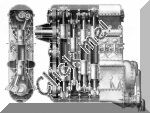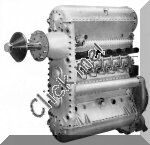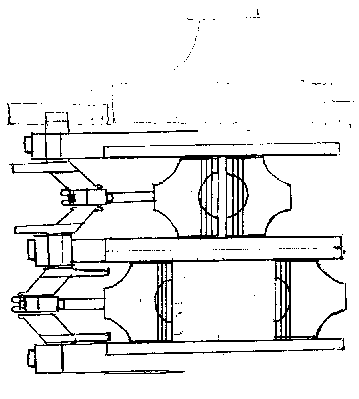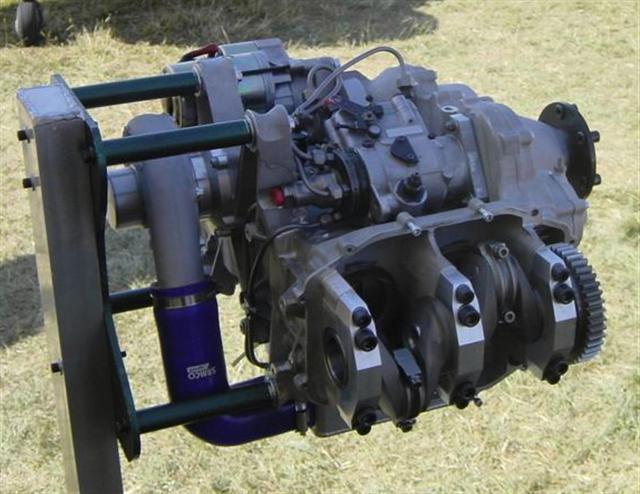
Welcome, from sunny Australia!
 |
New Aircraft Engine Diesel Horizontally Opposed |
 |
and more ...

Welcome, from sunny Australia!
 |
New Aircraft Engine Diesel Horizontally Opposed |
 |
and more ...
Piston aircraft engine haven't changed a great deal in the last few decades - All the Cessna, Piper, Beechcraft, Mooney, etc are made from alloy, horizontally opposed (like a Volkswagen Beetle or Porsche 911 engine), require high octane fuel (expensive & sometimes hard to get), require frequent rebuilds, and are particularly heat sensitive, ie, if you run the engine at cruise power then cut it straight back to idle you'll likely cause damage to the cylinders ...
There are solutions to each of these
problems, but they haven't been incorporated at the same time in the
single engine -
- Diesel engines aren't new in aircraft; the
Germans and Japanese used them extensively in the middle of the 20th
century. One of the problems with diesels is that the block and
cylinders are typically heavy, compared to an equivalent petrol engine.
Weight is critical to aircraft, and so the diesel fell from use.
- Air cooling of aircraft piston engine
creates a fair amount of aerodynamic drag, and if they're liquid cooled
then there is the extra weight of radiators, etc.
 |
This is a WW2 Junkers opposed piston diesel aero engine. It
was used in a high altitude bomber.
|
 |
I thought that with the recent advances
in ceramic engine technology, these two problems could be minimised, ie,
by using a ceramic-metal matrix great strength for little weight
components could be made. A ceramic block and ceramic-supported cylinder
sleeves could be made for at least the same weight and greater strength
as comparable alloy units.
So, from an engineering point of view, it
shouldn't be too hard to make a diesel engine with roughly the same
weight as a petrol one, but a diesel engine traditionally makes less
power for the same capacity as a petrol one does ... unless it's run as
a two-stroke. A two-stroke engine has twice as many power strokes per
minute as a four-stroke, so it's a heck of a lot easier to make good
power with a two-stroker.
One of the problems with two-strokes, and
diesels in general, is that they are usually 'dirty', because of the
sooty exhaust and high exhaust emissions, compared to petrol engines.
The solution for this is the latest high-pressure fuel injection systems
- They inject the diesel fuel as the piston reaches top dead centre,
which reducing emissions. The latest injection nozzles run at a few
thousand PSI, and are very good at producing a fine spray pattern which
as a bonus is the best way to reduce sooty exhaust smoke and emissions.
All of the above is the latest engine technology to improve strength, reduce weight, improve power, etc, but to go further I think that we should look to the past for guidance. In the 30's, 40's, and perhaps the 50's, engines were made that had twice as many pistons as cylinders! The cylinders had a crankshaft at either end, and pistons that almost met in the middle at top dead centre. This type of engine was revived briefly in the 60's, by the English company, Commer. They used it in a sort-of delivery van, and because of the odd piston arrangement (and other reasons) it was known as the 'Commer Knocker'. (and for other reasons, this is a source of amusement for the English ... :) ) The engine only had a single crankshaft, however, and so the pistons worked via a rocker system and a pair of con-rods. It also had a small supercharger, and so made quite a racket when going up hills!

Anyway, this is a pretty good idea, I
think - You get the same swept volume for an engine that is shaped a lot
like an old VW Beetle or Porsche 911 horizontally opposed engine, but
without the extra complexity and possible sealing problems of all those
cylinder heads. Hence, the main difference is that the crank cases would
be at the ends of the cylinder bores, instead of in the middle like a
'normal' engine has. This would normally cause the ends of the engine
to have large bulges, to accommodate the throw of the crank pins, but I
think that the way to go would be to have a fairly short stroke crank -
at both ends - and so the necessary bulges would actually be fairly
small. A short stroke normally means low torque, while high
torque is needed for propellor driven aircraft, but I have a plan to
solve that.
The opposed cylinder/piston shape engine is
a good one for light aircraft, due to the shape of the cowling at the
front and sometimes rear of the aircraft. They typically run the
propellor at a maximum of 2700rpm, and I think that my engine design
would be best run at least twice or more likely three times that speed.
There's two reasons for this -
- By running the engine at a higher speed,
it can make more horsepower. Since HP is actually a synthetic figure
derived from RPM and torque alone, if you have an engine that spins
spins quickly and makes good HP, then you can gear it down and convert
that HP to make very good torque.
- The engine would have a crankshaft at the
extreme ends, and so to make the propellor pick up it's power from the
centre of the engine, I'd have a small pair of toothed pulleys - one per
crankshaft - and a bigger one - about two to three times larger - in
between them that drives the prop. A pair of rubber belts connect the
three pulleys.
It'd all look something like this -

Note that I've only drawn in half the engine
here, as the righ hand side is the same. On top - not very clearly, unfortunately
- is the rubber belt driving the propellor pulley from the two smaller crank
pulleys.
Cooling the current engines is a major source of aerodynamic drag. The beauty of ceramic engines is that they need little or no cooling at all! So, the requirement for air being ducted through the cowling could be cut to, at a guess, about 25% of current engines ... maybe less. The only real cooling would have to be for the oil, which would have to be a high quality synthetic to take the heat. Diesels run more efficiently when run hot, so this is a benefit as well.
The end result would be a package much the same as a current petrol aircraft engine, but run a lot smoother (courtesy of the rubber belt damping the majority of the crank-to-prop) vibrations, be more fuel efficient (thanks to being a diesel, which are traditionally about 30% more fuel efficient than an equivalent petrol engine), run cleaner (thanks to modern injection, which the current Lycomings & Continentals aren't really pursuing), be more reliable (no ignition system, being a diesel, and being a two-stroke it has no inlet or exhaust valves & springs, etc), be cheaper to run (diesel fuel is quite a lot cheaper than Aviation Gasoline, and I think that the engine could be made to run on Aviation Turbine fuel - a sort-of diesel anyway), and lastly make me a lot of money .... Oops! That one just slipped out! :):)
I've talked about this engine with an aviation engineer, and he said that it would be a good thing, but he was concerned about the engine torque distorting the crankcases and cylinders. I countered that with the fact that the engine itself isn't making a great deal of torque as such, because it's geared down about three times to make all the torque at the prop, so compared to a current aircraft engine it could be built quite a bit lighter as it doesn't have to be stressed to take 300% (or so) higher torque of the 'old' engines. (At the prop hub)
As with the other ideas on these pages, it's just a thought, but I think that it could really improve the aircraft engine industry. We have the technology to build an engine like this, but the aviation industry is so blinkered that any changes are usually minor, or otherwise ignored.
Unfortunately.
However!
 |
A company in the UK has been building a similar engine to what I have described above. They use an alloy case and gears instead of ceramic & belts, and have added a small compressor for more altitude capability, but it's otherwise much the same. So here's a very good picture of what I was trying to describe above, and in the photo you can see how the crankshaft sits on the end of the block For lots more info on this engine and it's propects, please visit Diesel Air in the UK. |
On to the -
- Geothermal power
plant
- Laptop computer
electronic circuit simulator
- Anti-aircraft
missile system
- Different electric
car
- Listening spy device
- Super cooler device
- Radar Jammer
- Land speed record
car contender
- Water speed record
contender